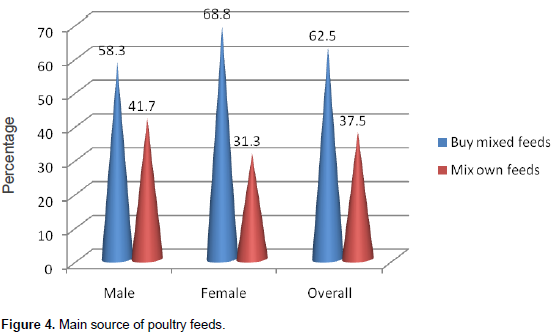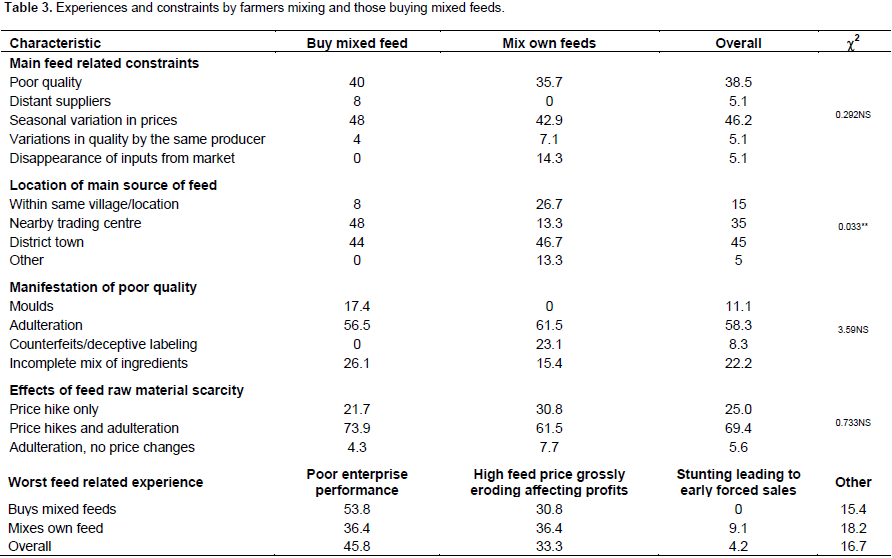ABSTRACT
This study was conducted to assess the effects of absence of a legal framework regulating the animal feeds industry on poultry value chain actor performance and sustainability. The objectives of the study were to identify the key constraints faced by individual farmers, livestock feed manufacturers, and field veterinary personnel; and assess challenges cutting across the industry actors. Data used in the study were collected using formal survey techniques and key informant surveys. Farmers who mix their own feed and those who buy already mixed reported poor quality and seasonal variation in prices as the main constraints associated with feeds. Adulteration of feed was mostly linked to scarcity of crop-based raw materials, namely maize, sunflower, cotton seedcake, and soya bean and those obtained from lakes, such as lake shells and haplochromis (silver fish) whose supply is seasonal in nature. The following findings are unveiled from the study. Intensive commercial poultry is a major source of income especially to female headed households. Long-term investment in housing structures confirms that farmers have a strong resolve to sustain poultry farming as a priority income generation enterprise. Performance, gains, and delivery of services by all value chain actors - farmers, feed manufacturers/ mixers, and field veterinary officers are adversely affected by lack of a regulations and standards as a result of absence of the animal feeds act. It is concluded that innovation platforms that bring together actors would be necessary to lobby government on legislation. This would enhance improved grain drying and bulk storage and put in place trade barriers restricting exportation of primary farm produce especially maize grain/bran. It is recommended that research expedites efforts to develop and promote energy substitutes to maize.
Key words: Innovation platforms, policy, public-private-participation, supply chains.
Commercial chicken layer and broiler producers heavily consume manufactured feeds as compound concentrates or value added bran, cereal or oil seed by-products on a daily basis (NARO-LSRP, 1999). As a result of this, feeds constitute over 70% of the cost of production in chicken enterprises (Louw et al., 2011). According to Frame (2008), a chicken will only grow and perform to the extent it receives proper nutrition. Besides, feed quality will affect feed consumption if compromise can cause disease or nutritional deficiencies. The animal feeds policy Ministry of Animal Industry and Fisheries (MAAIF, 2005) was formulated to realize a vision of an animal feeds industry that contributes significantly to improved animal production and productivity, thus improving the welfare of Ugandans and the national economy. The policy is based on the principles of promoting private sector participation, good manufacturing practices, and quality control stimulating a competitive animal feeds industry, providing suitable regulatory institutional framework and infrastructure for delivery of support services.
The policy specifically aims at stimulating increased quality feed production and reduction of feed production costs. Although, the objectives and functions of key stakeholders are defined and compliance to national development plans is clearly laid out, while legislation of the act is still lacking. This means that the feeds industry actors are neither regulated nor guided. As a result of incomplete legislation of the animal feed industry actors proliferation of informal (non-branded) feed, manufactures have dominated the feed manufacturing and mixing domains. Such intermediaries operate side by side with branded commercial feed manufacturers, such as Ugachick, Hilltop, and Formula feeds whose manufacturing practices are similarly hitherto not regulated by Act of Parliament. Other feeds supply chain actors notably farmers are hence exposed to risks of adulteration, counterfeits, and disguised labeling. This in turn leads to poor egg and meat yields and huge decline in production volumes that erode potential gains by the various actors in the industry. Apart from farmers who have a producer cooperative, informal feed manufactures and mixers operate in isolation.
Since there are no compelling standards, industry licensing conditions and tax regimes, they individually package feeds, make marketing strategies and deal with farmers using various approaches. There is no motivation for horizontal collusion and commonality in standards and addressing common challenges. On the other hand, government has slackened the process of enacting the feed act. One possible cause of this is failure for producers to successfully lobby government. Besides, consumers cannot rise up and challenge government on ensuring that the quality feeds are availed to chicken producers, because local chicken demand is partially met by imports. Consumers would still get fresh chicken even if local production is not supported. The main objective of this study was to assess the constraints faced by key actors in the industry in the wake of absence of a legal framework regulating the industry. Specific objectives of the study were to: identify key constraints faced by individual farmers, feed manufacturers, and the field veterinary personnel; assess challenges cutting across the industry actors due to lack of a networking umbrella organization; and provide information and make recommendations necessary for accelerating the national feeds policy development.
Sampling procedure and data management
Chicken meat value chain consists of several actor, such as farm input provision that include feeds, drugs, and feed ingredient suppliers, chicken farmers, chicken wholesalers, and retail outlets through hoteliers, restaurants, fast foods operators, and road side roasters who prepare fresh dressed whole or pieces of chicken. Similarly, the egg value chain actor stems from feed and feed ingredient suppliers, feed mixers, egg wholesalers, retailers, roadside, restaurant, and fast food operators. Assessment of the system demands sufficient information on challenges faced by individual economic units and stakeholders that may be vertically or horizontally cutting across the value chain actors in the feed industry in Uganda. According to UBOS (2009), the national chicken flock for Uganda is estimated to be 37.4 million in 2008 and the Eastern Region had the highest number of chickens estimated to be 10.7 million (28.6%). Jinja district was selected for the study based on its peri-urban nature, small land holdings, availability of branded feed manufacturing firms, such as Unga Ltd and Hilltop and presence of several commercial broiler and layer chicken units across the district. In total, the district has about 470,000 chickens (UBOS, 2009).
Jinja district is located in the Southwestern part of the Eastern region of Uganda. It is made up of three counties, namely Kagoma, Butembe, and Jinja municipality. The bulk of the data used in the study were collected using formal survey techniques based on standard questionnaire and direct interview techniques. These were supplemented by key informant surveys that included expert opinion interviews from the veterinary department, sub-county National Agricultural Advisory Services (NAADS) Coordinators (SNCs) and feed suppliers. A household formal survey was conducted in three divisions of Jinja district, namely Mpumudde/Kimaka, Mafubira and Bugembe. At farm-level, a household was the sampling and analytical unit. Households selected covered variability in terms of proximity to the input and product market/degree of urbanization, diversity and potential crop-livestock integration and degree of public and private veterinary treatment, extension and advisory contact.
A household was defined as a group of persons who live in the same dwelling and eat together, often have same principle decision maker(s), and utilize exclusive livelihood resources, such as domestic land. Sampling of households was done using multi-stage, purposive and systematic random techniques. The thrust of this study was feed legislation. Absence of adherence to regulations and standards often make farmers get exposed to vagaries of fake and/or poor feeds on the market. Apart from raising cost of production, such feeds can make farmers incur financial losses through bird stagnation, poor growth, meat and egg productivity performance. To counter these effects and as a sign of lack of confidence in the formal feed supply sector, farmers then mix their own feeds. Commercial layer and broiler farm households tend to operate in a similar fashion when it comes to feed mixing. Majority of the used maize is as the basal energy source, silver fish as the protein component and ingredients like cotton seed cake, lake shells and multi-vitamin pre-mixes to incorporate additional miners and vitamins. Given this nature of homogeneity, a representative sub-sample size of 35 respondents would be sufficient to conducts the descriptive statistics (means, percentages, chi squares, and t-tests) that characterize the bulk of this study.
On the basis of sources of poultry feeds, farmers were categorized into those who mix their own feeds (45) and those who buy pre-mixed feeds (35) giving a total sample size of 80 households. Variations in characteristics of household by gender and source of poultry feeds were examined using SPSS Computer Package (Version 16). Gender was considered to be an important factor because in Uganda women and men in urban and peri-urban areas with formal employment tend to supplement their monthly income and improve home nutrition by keeping egg or broiler commercial units. Unemployed house wives and women in similar localities keep commercial egg and broiler chickens to boost and/or have a steady source of income. Qualitative data were extracted using expert opinion interviews on experiences and constraints in quality and inter-seasonal feed supply, coping mechanisms and potential solutions in the situation of non-existent enforceable policy framework. This was supplemented by physical verification using direct observation of farm and feed production units. In addition, laboratory analysis using Near Infra Red Spectrometry (NIRS) was made on samples of feeds from 12 formal and informal mixers and manufacturers.
Supply chain actors’ experiences on feed quality
Key feed related constraints and challenges, main effects. and potential solutions as viewed by feed manufacturers and district field veterinary department are discussed in this section. These findings indicate that risk aversion in relation to poor feed quality, exportation of primary products especially maize grain and bran to neighboring counties, seasonal price changes and distant sources of raw materials are the major challenges faced by feed manufacturers. These conditions affect the performance of commercial chicken firms through premature and unplanned sales whenever maize cost shoot beyond Uganda shillings 1000 (One USD ($) is equivalent to about 3500 Uganda shillings). By so doing the usual economic life span for layers to about seven months instead of eighteen months and stunting of broilers is reduced. Besides, farmers are now turning to intensively rearing of slower growing and less efficient egg producing local birds or crosses. In addition, they opt for mixing their own feeds which may lack some ingredients. This results into incomplete rations. In relation to this, Webster (2005), indicated that hens need a balanced and adequate diet to maintain egg production.
Each egg contains significant amounts of protein and energy, which must first be consumed by the hen as part of its daily food intake. Too little dietary energy or an imbalance of amino acids can cause depressed egg production. Where mixing is done by commercial informal feed mixers, farmers often prefer to personally supervise feed mixing to ensure accurate and complete mix of all desired ingredients. In worst extremes, farmers have completely abandoned the poultry business due to prohibitive feed prices. These findings concur with New Vision (2012) who reported that deadly chicken feeds flooding the market by unscrupulous dealers in districts of Mukono, Wakiso, Jinja, Luwero, Mpigi, and Kampala caused farmers loses of million Uganda shillings. They cited an example, a 56% reduction of egg production from 180 to 80 trays a week leading to closure of the multi-million household poultry farming project that was generating more than 4 million Uganda shillings per month in 2011. Government interventions in form of movement controls, prohibitive trade licensing of essential feed and feed ingredient storage and marketing restrictions curtailed exportation of feed ingredients in India (Balakrishnan, 2001).
Findings on challenges faced by the veterinary department indicate that lack of legal backing to resolve conflicts among value chain actors, absence of self-regulating mechanisms among suppliers and lack of feed standards are the key challenges faced by the field vets. These have led to crippling of the veterinary service in enforcement of quality assurances measures, and prosecution of offenders. These have in turn led to distrust of the department by especially afflicted farmers and this is still paralleled by continued proliferation of fake feed dealers. Similarly, New Vision (2012) observed that such problems are bound to persist due to lack of relevant legislation yet policy that would restrain the private sector-led industry from deliberate adulteration. Besides, a matching fine of not exceeding Uganda shillings 480,000 or imprisonment of not more that 12 months provided for in the policy as was passed seven years ago are no longer prohibitive to offenders.
Given these challenges, it is logical to suggest that feed standards be established with prohibitive legal instruments and penalties, register and license feed manufacturers, train, regulate and regularly inspect their premises and products they put on market and form self regulating or peer monitoring, learning umbrella bodies. In order to verify farmers’ complaints about quality of commercial feeds, a laboratory analysis of commercial poultry layer and broiler feeds by National Livestock Resources Research Institute (NaLIRRI) of National Agricultural Research Organisation confirms that poultry feeds on the market were below the recommended standards. Both broiler and layer feeds were below recommended Crude Protein (CP) and Metabolisable Energy (ME) levels (Figures 1 and 2). The corresponding figures were 17 and 16.1% DM for CP as compared to the recommeded levels of 20 and 17%, for broilers and layers, respectively. A similar trend is observed on ME where about 600 and 400 Kcal/kg DM broilers and layers are deficient on the recommended critical level of 3000 and 2800 Kcal/kg DM for broilers and layers, respectively.

Socio-economic characteristics and household domestic resources
Key chicken enterprises, main sources of livelihoods and contribution of poultry enterprise to cash income
Findings of the study show that 40% of poultry farms are female headed (Figure 3). Layers were the most common enterprise managed in the area (55%). Broilers were kept by a sizeable (35%) proportion of the female headed households, because of their ability to generate faster returns to investment. According to Ngugi et al., (2002) women played the major role in the management of the chicken and were involved in decisions related to the chicken. Similar to what was observed by key informants, as a risk averting measure, about 6% of the female headed homes intensively kept local chicken and/or crosses whereas about 15% of the households kept a combination of layers and broilers (Table 1). Similar to Nanyeenya et al. (2013), in the area studied, poultry farming was the major source of livelihood (45%) for especially to female headed households (56%). With respect to type of feed used, findings indicate that most (62%) of the households bought mixed feeds from branded and non-branded feed companies. Poultry farming was a main source of cash income for most (61%) of the households, but more so for female headed ones (88%).


Investment in poultry feed, housing and farm labour
Findings of the study on farmers’ investment in feeds, housing and farm labour are presented in Figures 4 to 6. A sizeable proportion (38%) of farmers bought ingredients and mixed their own feeds. On the whole (overall), the entire sample 62.5% of the farmers bought mixed feeds. This concurs with Fanatico (2003) who noted that some producers decide to mix their own rations in order to be assured that genuine ingredients and the required proportions are used. Those who mixed their own feeds cited lack of confidence in what has been already been mixed as the major reason for mixing their own feeds. The rest of the famers bought already mixed feeds. Those who buy mixed feed stated that mixing of especially chick mash requires a unique precision and expertise that they lack. This was underscored by Beyer et al., (2001) who confirmed that commercial feed purchased from a reliable dealer, has all the nutrients chickens need to grow and thrive.


There was substantial investment in poultry housing as indicated by majority (74%) of households rearing their flocks in iron-roofed deep litter systems (Figure 5). This is in agreement with Kitalyi (1997) who stated that proper housing that should be constructed using locally available materials to create a favourable environment and guard against snakes, rats, dogs, cats, foxes, and thieves. It was discovered that majority of the households (45%) relied on family labour, a combination of house-help and poultry management hired workers (37%). Only 18% of households hired farm labour whose exclusive responsibility was poultry management and farm work (Figure 6). This has implications on targeting and effec-tiveness of training that is often skewed towards enterpise owners rather than actual managers and/or family or hired workers. Socio-economic characteristics of farmers who mix their own feeds and those buying mixed feeds are shown in Table 2. Those who mix their own feeds have significantly larger land sizes where they grow some of the crops used as raw materials for feeds, such as maize.

These two farmer typologies were similar in terms of factors like chicken flock size, age of household heads, household size, level of education, poultry farming experince and cattle herd size. There was, however, significant differences between male and female headed households with respect to business ownership. A large proportion of enterprises (50%) among female headed households belonged to the head herself. In male headed households, a more or less corresponding figure (54%) belonged to other family members. With respect to group membership, about 40% of male and female headed households did not belong to farmer groups. Producer groups facilitate easier access to inputs, feed supplementation, improved birds, drugs and vaccines, technical advice, access to credit, training, transportation and marketing of poultry products (Aini, 1990 in Branckaert et al., 2000). Results of seasonality, price, and quality changes in both raw materials and feeds bought by farmers who mix their own feeds and those who buy mixed feeds are shown in Table 3. Irrespective of whether they mix their own feed or buy already mixed feeds, farmers reported poor quality and seasonal variation in prices as the main constraints associated with feeds.

This concurs with Ja’afar-Furo and Gabdo (2010) who cited high price of feeds as being the major constraint to poultry production in Nigeria. Besides Branckaert et al., (2000) noted that by identifying and using locally available feed resources can be done to formulate low cost diets that are as balanced as possible.
Adulteration of feed was mostly linked to scarcity of raw materials, many of which especially the crop-based such as maize, sunflower, cotton seedcake, and soya bean and lake based ones such as cowrie shells and haplochromis (silver fish). Adulteration of feeds and seasonal price hikes lead to rise in cost of production and closure of some chicken enterprises. Given that chicken meat is preferred livestock meat by all Ugandan cultures, once it losses good quality and affordability possibility of importation of whole chicken that further threaten the already challenged chicken industry fills the gap. Imported chicken from Brazil hit the market at about 8,500 shillings compared to 12, 000 shillings for locally produced birds. It is hence not surprising that farmers cite poor enterprise performance as the worst feed related effect.
CONCLUSIONS AND IMPLICATIONS FOR RESEARCH AND DEVELOPMENT
Risk aversion related to poor feed quality, exportation of primary products especially maize grain and bran to neighboring counties, seasonal price changes, and distant sources of raw materials are the major challenges faced by feed manufacturers. Lack of legal backing to resolve conflicts among value chain actors, absence of self-regulating mechanisms among suppliers and lack of feed standards are the key challenges faced by the field vets. Irrespective of whether they mix their own feed or buy already mixed, farmers reported poor quality and seasonal variation in prices as the main constraints associated with feeds. Adulteration of feed was mostly linked to scarcity of raw materials especially the crop-based such as maize, sunflower, cotton seedcake, and soya bean and lake based such as lake shells and haplochromis (silver fish) that are seasonal in nature. The following conclusions are drawn from the study:
(1) Intensive commercial poultry is a major source of income especially to female headed households
(2) Long-term investment in housing structures confirms that farmers have a strong resolve to sustain poultry farming as a priority income generation enterprise
(3) All actors’ farmers, feed manufacturers/mixers and field veterinary officers performance, gains and delivery of services are adversely affected by lack of a regulatory, legal framework that would be provided by an Animal Feeds Act.
It is therefore recommended that the following areas be addressed by research and legislation:
1. Enhance improved grain drying and bulk storage, put in place trade barriers restricting exportation of primary farm produce especially maize grain/bran. Alternatively, research should develop and promote energy substitutes to maize since export of maize grain and bran offer a reliable market to Ugandan maize producers and processors.
2. Parliament should pass the Animal Feeds Act, establish feed standards, together with the relevant prohibitive legal instruments and penalties, and define roles of various stakeholders (veterinary department, farmers, local governments, quality assurance, feed raw materials and input (ingredients) suppliers.
3. Value chain actor business performance will be enhanced by value chain actors forming innovation platforms to address common constraints.
The authors have not declared any conflict of interests
This publication is an output of a NaLIRRI project funded by under ASARECA Livestock and Fisheries Program. Stakeholders in the poultry industry, farmers, NAADS staff, field veterinary officers and feed dealers in Jinja district are particularly appreciated for their valuable contribution.
REFERENCES
|
Aini I (1990). Indigenous chicken production in South-east Asia. World's Poult. Sci. J. 46:51-57.
Crossref
|
|
|
|
Balakrishnan V (2001). Developments in the Indian feed and poultry industry and formulation of rations based on local resources. Madras Veterinary College Chennai, India.
|
|
|
|
|
Beyer RS, Moritz JS, Wilson KJ, Cramer KR (2001). The Effect of Feed Processing and Feed Form on Animal Performance Kansas State University, USA.
|
|
|
|
|
Branckaert RDS, Gaviria L, Jallade J, Seiders R (2000). Transfer of technology in poultry production for developing countries FAO Rome Italy.
|
|
|
|
|
Fanatico A (2003). Feeding Chickens for best health and performance National Center for Appropriate Technology (NCAT) Poultry Site Online Weekly Newsletter.
|
|
|
|
|
Frame DD (2008). Principles of Feeding Small Flocks of Chickens at Home AG/Poultry/2008-02pr Utah State University USA.
|
|
|
|
|
Ja'afar-Furo MR, Gabdo BH (2010). Identifying major factors of poultry production as sustainable enterprise among. Farmers Using Improved Methods in Rural Nigeria. Int. J. Poult. Sci. 9:459-463.
Crossref
|
|
|
|
|
Kitalyi AJ (1997). Village chicken production systems in developing countries: what does the future hold? Louw A, Schoeman J, Geyser M (2011). Broiler industry supply chain study with emphasis on feed and feed-related issue. University of Pretoria, Pretoria, South Africa.
|
|
|
|
|
Ministry of Agriculture, Animal Industry and Fisheries (2005). The national animal feeds policy. Entebbe, Uganda.
|
|
|
|
|
Nanyeenya WN, Mugisha A, Musinguzi SP, Magambo R, Senoga M (2013). Constraints, Livelihoods and Technology Adoption of Village Chicken Producers in Uganda LRRD November 2013.
|
|
|
|
|
NARO-LSRP (1999). Livestock Systems Research Program-National Agricultural Research Organisation Jinja district diagnostic survey report Kampala - Uganda.
|
|
|
|
|
New vision newspaper (2012). Deadly chicken feeds flood market. The New vision September 11, 2012, Kampala – Uganda.
|
|
|
|
|
New vision newspaper (2012). Uganda loses billions in poultry imports. New vision July 6, 2012, Kampala – Uganda.
|
|
|
|
|
Ngugi NJ, Nyogesa DJW, Okitoi LO (2002). Gender concerns in research and household poverty reduction: The case of Kenya Agricultural Research Project on Indigenous poultry in Western Kenya, Kenya Agriculture Research Institute (KARI) Annual report, Nairobi, Kenya.
|
|
|
|
|
UBOS-Uganda Bureau of Statistics (2009). Livestock Census report August, Entebbe Uganda.
|
|
|
|
|
Webster BA (2005). Several Reasons Why Your Hens May Stop Laying Eggs. Extension Poultry Scientist, University of Georgia Poultry Site Online Weekly Newsletter.
|
|






